BURLINGTON, ON August 15, 2012 It has been a challenge but there is a light at the end of the tunnel and it is going to get brighter and brighter. Five of the 42 beams needed to complete the building of the Pier at the foot of Brant Street are now on site and up to nine more will be delivered this week.
The plan is to have a minimum of five beams delivered every week until all 42 are on site and ready for installation.
With the nine that are scheduled – we say scheduled because they first have to pass a very rigorous inspection on Wednesday, the 15th, there will be enough steel for some of the erection work to be started. The crane needed to do the erection work will be in place early next week.
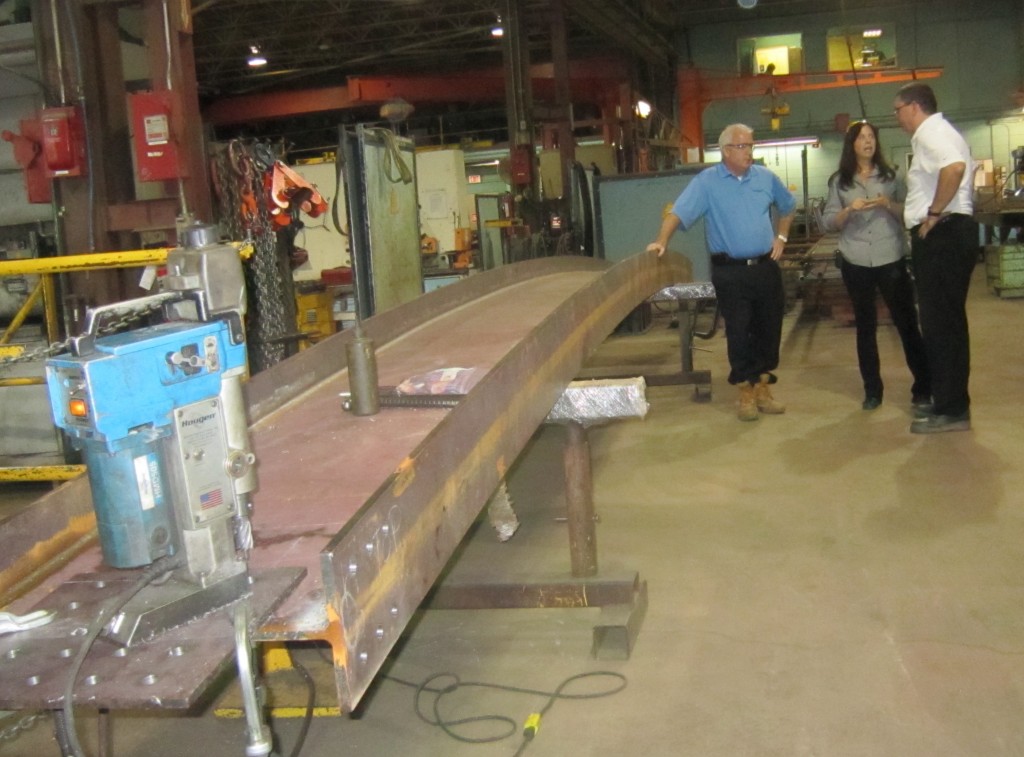
General Manager Scott Stewart with Deb Franke of AJ Braun and Craig Stevens discuss the welding of beams for the Pier. The progress schedule is top of mind for all three. One of the beams being welded is shown.
During a site inspection at the fabrication plant last week, city General Manager Scott Stewart, Project Manager for Corporate Strategic Initiatives, Craig Stevens and I traveled to Kitchener to get a firsthand look at the work being done and to inspect the quality logs.
Almost the first question Stewart had of Deb Franke, the woman running A. J. Braun, one of three companies welding the beams, was – “do you have a grip on the problems now and do you feel you are going to be able to get the fabricated steel out the door and onto the trucks on the schedule we have put in place? .
“I think so”replied Franke, “but I want to wait until Wednesday of next week to be absolutely sure.”
That Wednesday is today. There is a lot riding on the inspection which is very rigorous. But if all the welding work passes it will indicate that the fabricators have overcome the problems they were having. At one point the inspector failed all four beams one fabricator had produced – it was that bad.
The problems that are being worked through now go back to the shipment of steel plate that came in early in February that was rejected by the company doing the quality assurance work for the city. Unfortunately city hall wasn’t as transparent as they could have been and should have been with the public about having to order new steel. City Manager Jeff Fielding was recently quoted as admitting staff had erred in not informing council back in February or March that it had some concerns.
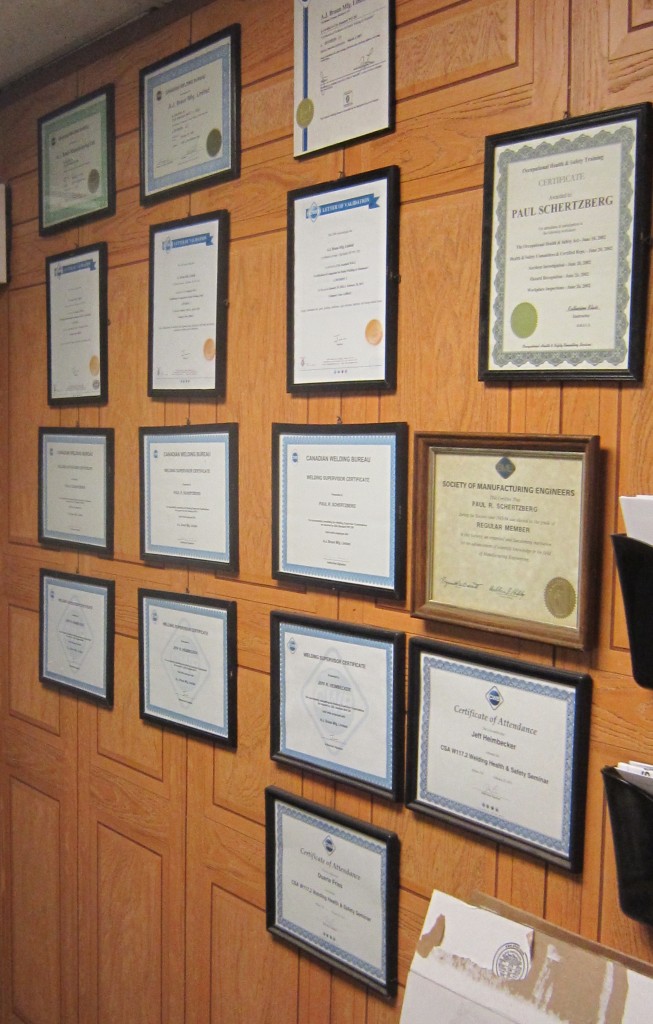
A J Braun, a Kitchener company doing much of the welding for the beams that will be used to create the deck for the pier has every certificate imaginable. If certificates mean anything – these people are qualified to do the job.
Staff has decided they will provide updates on the pier every three weeks, instead of every six weeks. Why not provide an update when you have new information?
The kind of steel plate needed to build the pier is not manufactured in Hamilton. The first shipment came from a country outside Canada. It did not pass the quality control tests.
The second shipment came from two different steel plate manufacturers in North America. Once the plates – which measured 40 feet wide 80 feet long – were sourced they had to be transported. That’s when CP Rail went on strike. Getting a truck to transport the steel turned out not to be an option – first there wasn’t much in the way of truck transport available and our steel could only be transported in daylight hours because of the length of the load.
City General Manager Scott Stewart said at the time that there wasn’t a problem that hasn’t managed to find its way into this project. Many believe there is a book in this experience. Opinion appears to be divided on whether the book should be written as a comedy or a tragedy.
As soon as the steel that was sourced from two mills in North America, it went to Brannon Steel in Brampton for cutting. We are talking about steel plate that is 7/8th of an inch thick and starts out as 40×80 foot in size.
When the plate is cut it goes to the fabricators. That’s when a new set of problems cropped up. It is vital that the welds on the steel be perfect – and that isn’t easily achieved. Its very technical and called for a level of perfection not normally called for in the construction field but, because these beams are going to carry a very heavy load of concrete that is poured once all the beams are bolted together – they have to be solid.
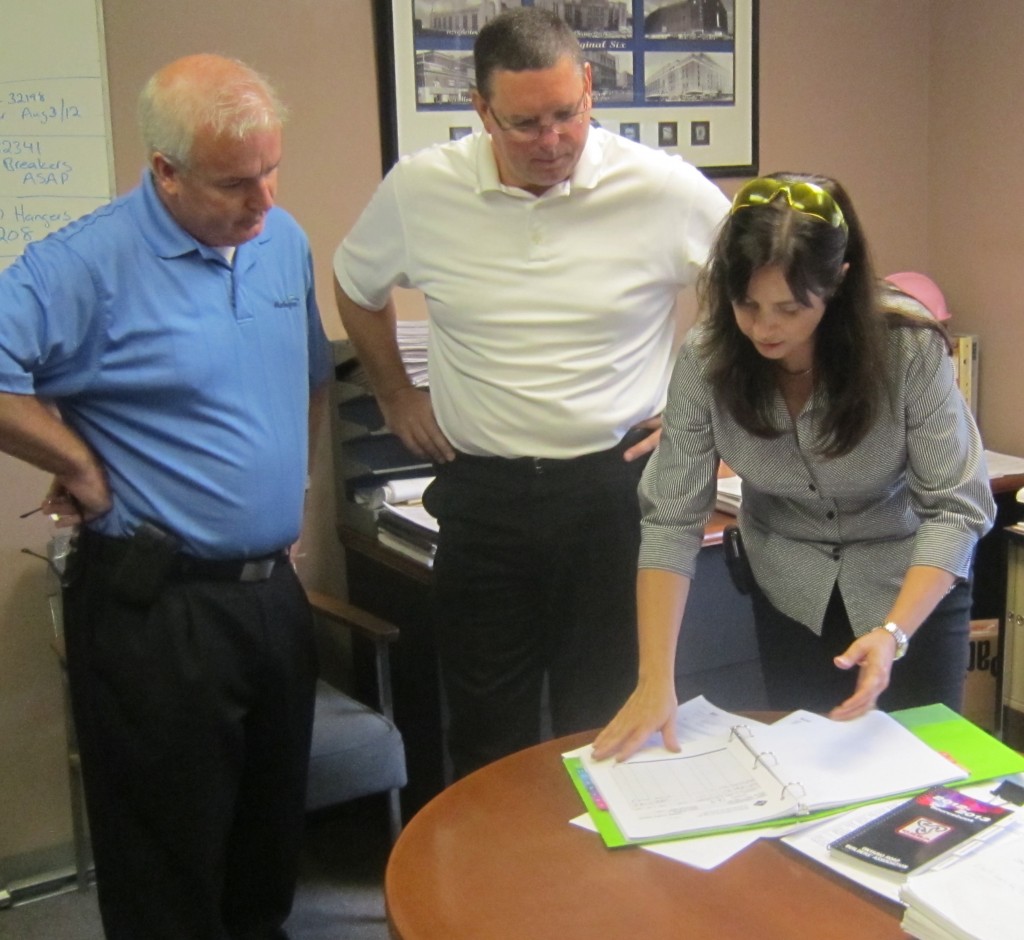
Every beam has 19 pages of documentation. General Manager Scott Stewart on the left and Project Manager Craig Stevens look over the reports that set out who did what when and how long it took to get the job done.
The city learned just how solid when a crane on the site during the first attempt at building the pier toppled over. That’s when it became evident that welds weren’t holding and that the tensility of the steel was not good enough. The tensile strength is the maximum stress that a material can withstand while being stretched or pulled. The city learned just how much tensility was needed when the crane toppled and at that time – there wasn’t enough.
Resource Industrial Group; A J. Braun and Bellcamp are now involved in the welding. Each shop do their own quality control with Herschfield Morrison doing the quality assurance on behalf of the city.
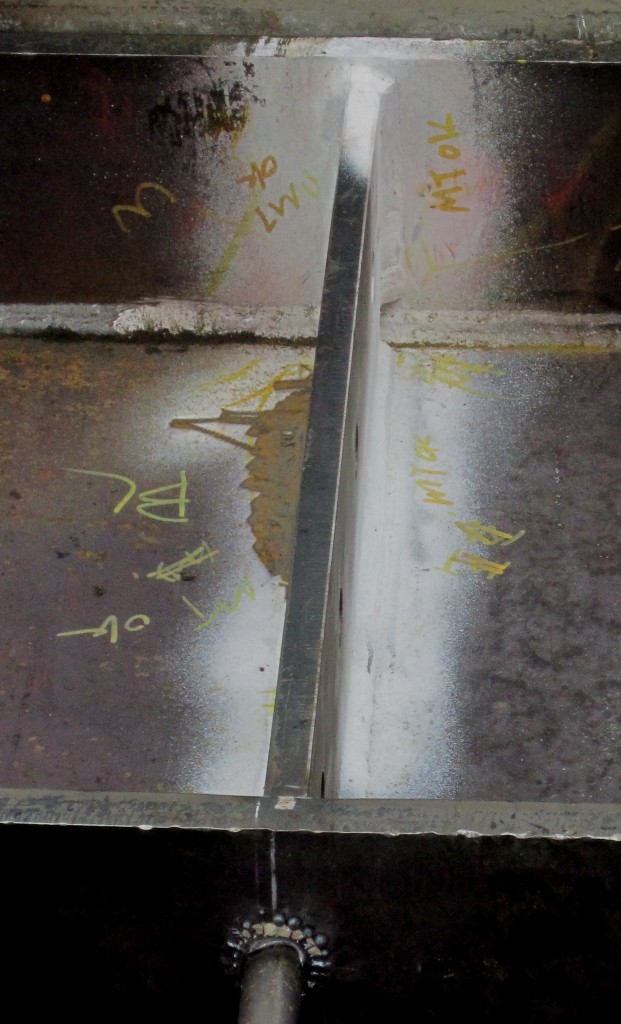
Every weld on every beam is inspected. Here, a beam with markings from the inspector is shown. Nothing is being left to chance.
At one point the inspectors sent back four beams that did not pass the tests – and that put the wind right up the you know what, at city hall. This project was never going to get done at this rate.
Traditionally one out of every five welds is inspected – this project has 100% inspection – they look at everything.
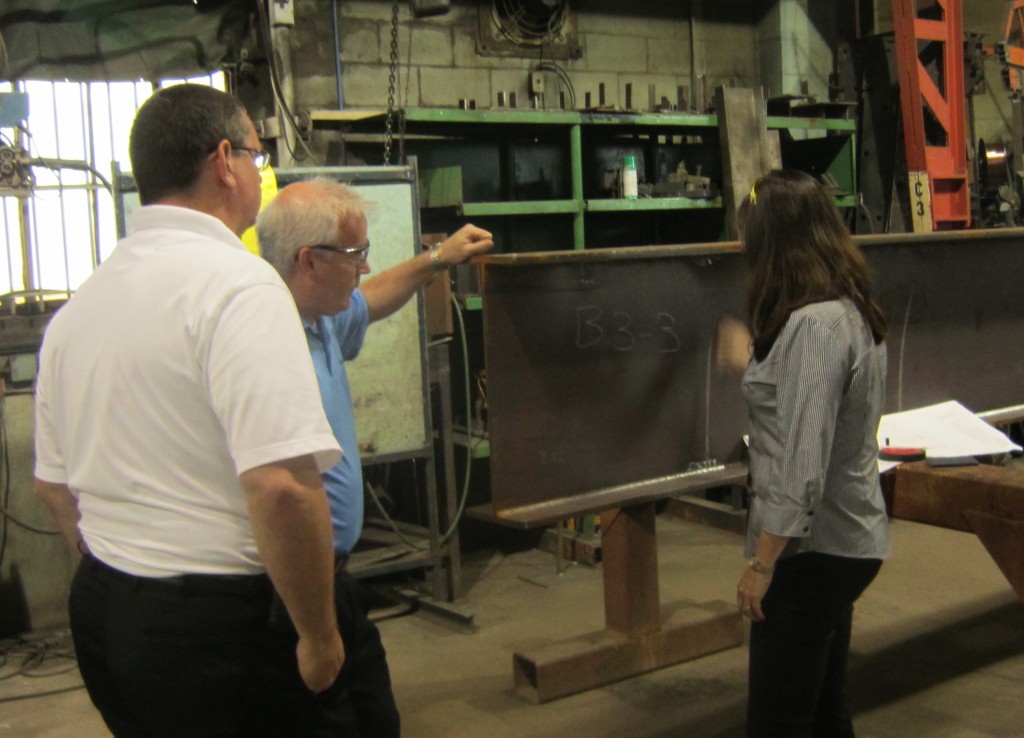
B3 – the problem beam.. Getting the welds done so they would pass quality assurance was easier said than done. Deb Franke, chief cheese at AJ Braun, one of three companies doing the welding work take Scott Stewart and Craig Stevens through the problems.
Deb Franke will tell you about beam B3 – it was a problem and had to be re-welded a number of times before they got it right.
Each welding shop does its own Quality Control – but it has to get past the Quality Assurance inspectors who are tough, tough, tough. Their job is to find something wrong and sometimes they don`t want to stop until they do find something wrong.
There are short studs, set a couple of inches apart, that are welded to each beam – they are in place to hold the concrete when it is poured. An inspector puts a long pipe on a stud and bends it. If all the studs do is bend bend and the welds don’t pop – it passes the test. If the weld pops – the stud fails. Now here is where we get a peek at just how rigorous this testing is. Two of the Nelson studs are bent for each test. If they pass – the beam is OK.
If one of the welds pops, that is it doesn`t hold, the next test is done to four studs. If any one of the four pops, the next test is 8 studs are bent, if anyone of them – fails, well you can see where this is going. Nothing is being left to chance.
There was one occasion when the inspectors basically shut down the A.J.Braun shop while they went through everything – the beams they were expecting passed.
Time and again the Quality Control inspectors would turn down a beam because the problems with the quality of the weld. There was one particular beam that seemed to be nothing but trouble for Deb Franke at A.J. Braun, a fabricator in Kitchener that had bid on the very first tender put out for the pier back in 2005.
Franke was very familiar with the project. `We had hoped to be a sub-contractor on that first attempt but we didn’t make the cut then. Seven years later Braun is the lead player in the team that is fabricating the beams along with two other fabricators.
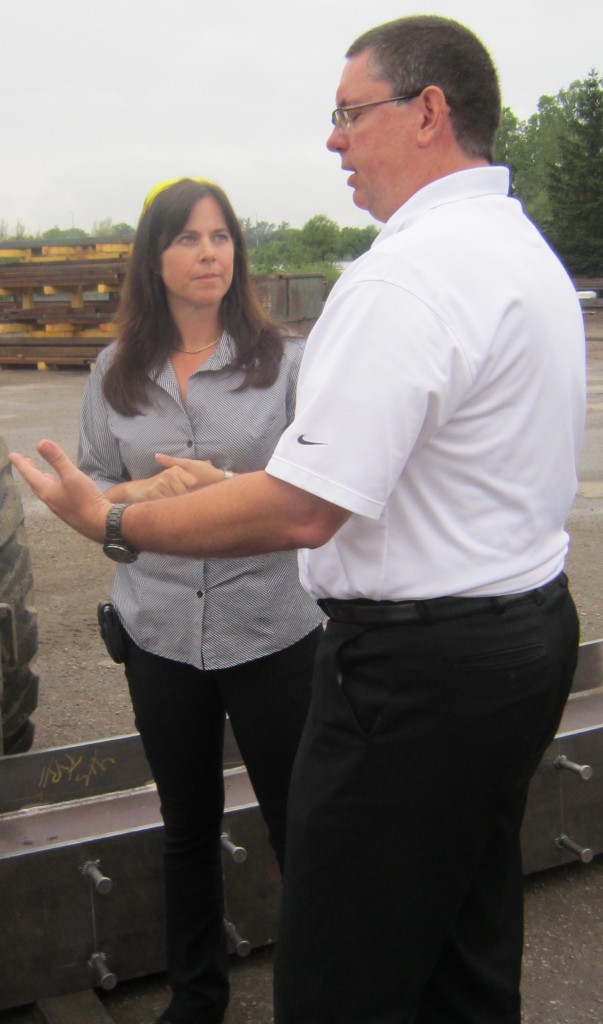
Here, Craig Stevens, Project Manager for the Pier and Deb Franke head of AJ Braun, the lead company on the welding side of the project are discussing B3, the problem beam.
Deb Franke was one of four daughters – `we suspected one of us was going to end up at the fabrication plant. Tucked away in the corner of her office is one of those pink construction helmets that Franke never wears – she doesn`t have to do cute to make her point. This is a no nonsense, get to the point and lets solve the problem kind of woman. Her shop works weekend shifts until this project sees the last beam go out the door.
When the beams have passed the welding inspection – they are both x-rayed and put through a magnetic particle test. The machine that does this is quite small but it is a vitsal part of the quality process and it has to have its own power supply.
A.J. Braun is doing all the railings for the pier as well. This is a line of fabrication they have a lot of experience with and they don`t see any potential for delays once all the beams are out of the galvanizers.
For Deb Franke, this project has been quite an experience. She isn’t the kind of person one expects to see at a fabrication plant. The business was owned by her father, Walt Bathe, who wasn’t able to keep up with the work load when he became ill. Deb found herself moving from rubber manufacturing into welding and shaping steel and aluminum mostly for the highway industry.
“We have learned so much on this contract” says Franke, “that we are now able to bid on jobs we didn’t know enough about before. We are now bidding on twice as many jobs as before because of this experience. We’ve learned a lot about how to improve quality control and are a better company because of this experience.”
At least someone is getting something out of the delays the city of Burlington has experienced.
Each of the 42 beams has extensive documentation. Every beam is given a number and is a part of a particular segment of the pier.
For each beam there are 19 pages of documentation that note every step taken; time in and time out of the shop; the results of each of the tests with notations showing which employee did the job.
If all goes well, the city will have the last of the beams at the construction site by the middle of September.
Craig Stevens, Project Manager on this one, serves as the right hand man for General Manager Stewart. The two talk several times a day. Stevens was heavily involved with the construction of the Performing Arts Centre and during his 24 years with the city he has been involved in Central Library Expansion, Brant Hills Community Centre and Branch Library Expansion and Renovation, Angela Coughlan Pool Expansion and Renovation, Aldershot Pool Expansion and Renovation, Aldershot Arena Expansion and Renovation, Seniors Centre Expansion and Renovation, Appleby Ice Centre Twinning and now the Pier. Except for the pier every project Stevens has been in on were completed on time and on budget.
Stevens, who has a degree in Landscape Architecture and hold a Project Manager Professional, PMP, began his career with Parks and Open Space. He was hands on with the Paletta Waterfront Park, City View Park Master Plan and our Waterfront Trail. The value of the projects he has been involved in exceeds $100M – which is quite a bit more than the city pays him.
Monitoring progress on close to an hourly basis at times, is what keeps Stevens busy and on the pier project is has gotten really messy – and this one isn’t over yet.
Wednesday, this morning at 5:30 am the inspectors were at all three welding companies to inspect three beams at each location. If they all pass, and they are expected to – they then get shipped off to the galvanizer where 6 mm of molten zinc coating is applied to every beam and then they are loaded on a truck and brought to Burlington.
The crane used to do the erecting so that the parts can be bolted together will be on site – and the city can see their pier being built – finally.
There is surely some way for the city to celebrate the arrival of that final beam.




















